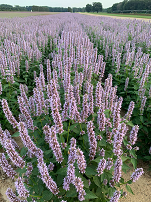Shop by Category
Shop by Brand
Shop by Brand
Agastache
Vibrant Blooms & Fragrant Foliage
Invite a flurry of pollinators to your garden with Agastache, commonly known as Hummingbird Mint. This charming perennial boasts vibrant, upright flower spikes in a variety of colors, from electric blues and purples to warm oranges and pinks. Its aromatic foliage releases a delightful minty fragrance, adding another layer of sensory appeal. Agastache is a low-maintenance, drought-tolerant plant perfect for sunny borders, rock gardens, and attracting wildlife.
- Pollinator Magnet: Attracts hummingbirds, bees, and butterflies with its nectar-rich flowers.
- Long Blooming Season: Provides continuous color from summer into fall.
- Aromatic Foliage: Releases a refreshing minty fragrance when crushed.
- Drought Tolerant: Thrives in dry, sunny conditions once established.
- Low Maintenance: Requires minimal care and is generally pest and disease resistant.
- Variety of Colors: Offers a wide range of flower colors to suit any garden palette.
- Deer Resistant: Generally unappealing to deer.
Optimal Conditions:
- Soil: Well-drained soil is crucial. Agastache prefers sandy or loamy soils and tolerates poor soil. Avoid heavy clay or waterlogged areas.
- Sunlight: Full sun (at least 6 hours per day) is essential for best flowering and growth.
- Hardiness: Typically, hardy in USDA zones 5-10, depending on the variety. Check variety specific information.
- Spacing: Plant seedlings or divisions 12-18 inches apart.
- Planting Depth: Plant at the same depth as the container it came in.
- Watering at planting: Water thoroughly after planting and until established.
Care Tips:
- Watering: Water regularly during the first growing season to establish a strong root system. Once established, Agastache is drought-tolerant and requires minimal watering.
- Fertilizing: Agastache generally does not require heavy fertilization. A light application of balanced fertilizer in spring can be beneficial.
- Deadheading: Remove spent flower spikes to encourage continuous blooming and prevent self-seeding (unless you wish to collect seeds).
- Pruning: Cut back stems in late fall or early spring to promote bushier growth.
- Division: Divide established clumps every 2-3 years in spring or fall to rejuvenate plants.
Key Features Summary:
- Attracts hummingbirds, bees, and butterflies.
- Fragrant, minty foliage.
- Drought tolerant and low maintenance.
- Long blooming season.
- Deer resistant.
- Wide range of colors.
 Agastache, Common Name: Anise Hyssop - One of the easiest and most rewarding perennials to grow!
Agastache, Common Name: Anise Hyssop - One of the easiest and most rewarding perennials to grow!
This is a great plant for hot, dry, sunny climates. Well-drained soil is a must, especially in the winter. This plant will not tolerate heavy clay soil but grows well in average to light soil with low to medium moisture levels. In the sandy soil of zone 5b trial gardens, this variety has overwintered with flying colors. Even so, it's officially listed as a zone 6 perennial so some winter protection might be required in cooler zones. No serious pest or disease problems have been reported with this plant.
